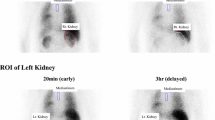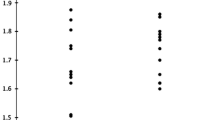Abstract.
The objectives of this clinical study using iodine-123 metaiodobenzylguanidine (MIBG) scintigraphy were (a) to evaluate cardiac sympathetic denervation in non-insulin-dependent diabetes mellitus (NIDDM) patients with and without hypertension and (b) to investigate the relation between cardiac sympathetic denervation and prognosis in NIDDM patients. We compared clinical characteristics and MIBG data [heart to mediastinum (H/M) ratio and % washout rate (WR)] in a control group and NIDDM patients with and without hypertension. MIBG scintigraphy was performed in 11 controls and 82 NIDDM patients without overt cardiovascular disease except for hypertension (systolic blood pressure ≥140 and/or diastolic blood pressure ≥90 mmHg). After MIBG examination, blood pressure was measured regularly in all NIDDM patients. There were significant differences between 65 normotensive and 17 hypertensive NIDDM patients with respect to age (55±11 vs 63±12 years, respectively, P<0.05), prevalence of diabetic retinopathy (12% vs 35%, respectively, P<0.05) and systolic blood pressure (120±12 vs 145±16 mmHg, respectively, P<0.001). The H/M ratio in hypertensive NIDDM patients was significantly lower than in the control group (1.81±0.29 vs 2.27±0.20, respectively, P<0.01). During the follow-up period (18± 12 months), 17 NIDDM patients newly developed hypertension after MIBG examination. There were no significant differences in their clinical characteristics compared with persistently normotensive or hypertensive NIDDM patients. %WR in patients with new onset hypertension was significantly higher than in the control group (30.88%±16.87% vs 12.89%±11.94%, respectively, P<0.05). Moreover, in these patients %WR correlated with duration from the date of MIBG scintigraphy to the onset of hypertension (r=-0.512, P<0.05). Five NIDDM patients died during the follow-up period (four newly hypertensive patients and one normotensive patient). There were significant statistical differences between the control group and non-survivors in terms of age (54±11 vs 73±11 years, respectively, P<0.01), H/M ratio (2.27± 0.20 vs 1.64±0.36, respectively, P<0.01) and %WR (12.89%±11.94% vs 42.52%±22.39%, respectively, P<0.01). In conclusion, cardiac sympathetic denervation using MIBG scintigraphy observed in hypertensive NIDDM patients, and was more profound in non-survivors. MIBG scintigraphy proved useful for the evaluation of NIDDM patients with new onset hypertension, and it was found that NIDDM patients with abnormalities on MIBG scintigraphy needed to be observe carefully.
Similar content being viewed by others
Author information
Authors and Affiliations
Additional information
Received 1 April and in revised form 27 May 1999
Rights and permissions
About this article
Cite this article
Tamura, K., Utsunomiya, K., Nakatani, Y. et al. Use of iodine-123 metaiodobenzylguanidine scintigraphy to assess cardiac sympathetic denervation and the impact of hypertension in patients with non-insulin-dependent diabetes mellitus. Eur J Nucl Med 26, 1310–1316 (1999). https://doi.org/10.1007/s002590050588
Issue Date:
DOI: https://doi.org/10.1007/s002590050588




